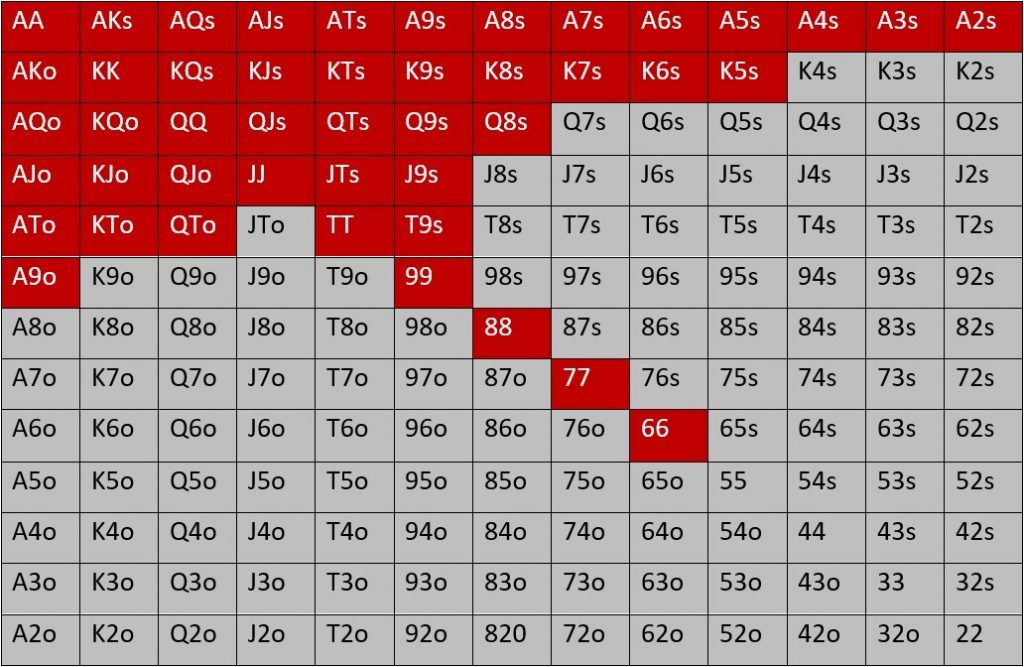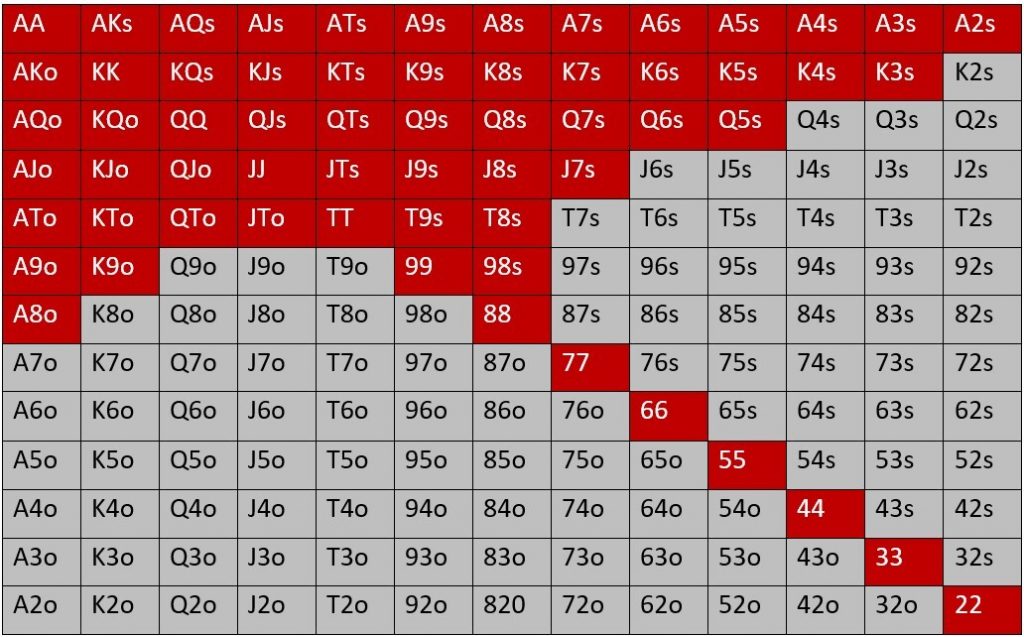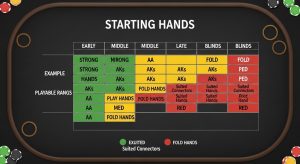Unopened pot
Open raise LJ


Unopened pot
Open raise HJ


Unopened pot
Open raise CO


Unopened pot
Open raise BTN


Unopened pot
Open raise SB


In poker, preflop opening ranges refer to the specific hands you choose to play when it’s your turn to act before the flop. These ranges are crucial to your overall strategy, as the way you open the pot can significantly influence the outcome of the hand. Understanding and adjusting your preflop opening ranges based on your position and the tendencies of your opponents is key to long-term success.
The Importance of Position
Your position at the table directly affects your preflop opening range. Players in later positions (closer to the button) can afford to open with a wider range of hands, while players in earlier positions need to be more selective. Here’s a breakdown of how your position impacts your opening range:
- Early Position (EP):
- From early position, you should play a tight opening range since you have little information about the actions of other players.
- Opening hands should generally include premium hands such as AA, KK, QQ, AK, and AQ, and sometimes hands like JJ and TT.
- Middle Position (MP):
- In middle position, you can afford to widen your range slightly, but still play solid hands. This includes hands like AT, KT, QJ, and 66.
- The idea is to play hands that have good potential and can dominate weaker hands in the blinds.
- Cutoff (CO):
- From the CO, your range can expand significantly, as you have fewer players acting after you. In this position, it’s common to open with a wider variety of hands, including suited connectors (e.g., 76s, 65s) and lower pocket pairs.
- The goal is to steal the blinds or create opportunities to outplay opponents post-flop.
- Button (BTN):
- The BTN is the best position to open a wide range of hands, as you will act last post-flop, giving you the advantage of gathering more information before making decisions.
- Here, you can open with almost any hand that has decent post-flop potential. This includes hands like A2s, K7s, Q9s, and all pocket pairs, as well as many suited connectors and one-gap connectors.
- Small Blind (SB):
- The Small Blind (SB) is a tricky position because you will be out of position for the rest of the hand. As a result, you need to open with a more selective range.
- A conservative opening range might include hands like AQ, KQ, JJ, and 99, but you can occasionally open up with suited connectors if the blinds are weak.
- Big Blind (BB):
- From the BB, you’re often forced to defend your blinds with a wider range, especially if players in late positions are opening the pot.
- You’ll typically defend with a broader range than any other position, including Ax suited, Kx suited, and small pairs like 33 or 44, depending on the player opening the pot.
How to Adjust Opening Ranges Based on Opponents
- Tight Players: If your opponents are folding too often, you can widen your opening range, particularly from late positions (BTN and CO). You’ll frequently steal blinds in this situation, making it profitable to open with weaker hands.
- Loose Players: If opponents are calling or raising frequently, tighten up your range, especially from early positions. You want to avoid playing marginal hands that could get you into difficult situations against stronger ranges.
Raising vs. Limping
- Raising: When you raise, you take control of the pot and set the tone for the hand. In most situations, it’s better to raise rather than limp, as it allows you to build the pot with strong hands and put pressure on your opponents.
- Limping: Limping (calling the BB) is generally discouraged unless there are specific circumstances, such as a weak player in the BB or several limpers before you. Limping is typically seen as passive, and in most cases, you should either raise or fold based on your hand strength.
Adjusting for Limpers
If several players have limped into the pot, you can adjust your opening range to exploit them. In these situations, you might want to raise with speculative hands like small pocket pairs or suited connectors, which have the potential to hit big post-flop. Your raise size should typically be 3 BB + 1 BB for each limper.
Recommended Preflop Raise Sizes
- Standard Open Raise: The general recommendation for a preflop open raise is to raise 3 BB. If there are limpers, you add 1 BB for each limper. For example, if two players limp, you would raise to 5 BB.
- Adjusting for Opponents: If players are aggressive or tend to raise frequently, you may want to increase your raise size to avoid getting out of position or to deter them from playing back at you.
Playing Post-Flop After Opening
After opening preflop, your decision-making should shift to post-flop play. If you have a strong hand, you can continue with aggression, particularly if you’re in a position where you can control the pot. If you have a marginal hand, it’s important to evaluate the board and your opponent’s actions carefully.
Conclusion: Mastering Preflop Opening Ranges Mastering preflop opening ranges is essential for building a solid poker foundation. By understanding the importance of position and adjusting your range based on your opponents, you can maximize your profitability and minimize risk. Remember, your preflop decisions set the stage for the rest of the hand, so being selective, strategic, and adaptable is key to long-term success at the table.





